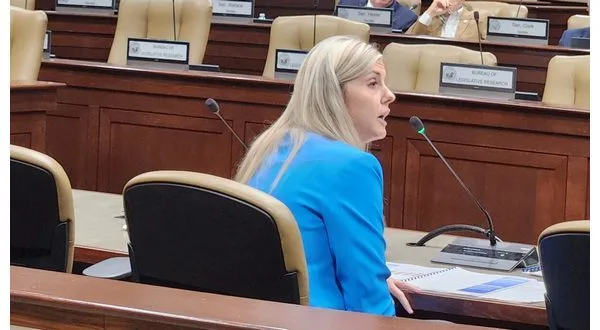
Tiffany Wright, director of the Arkansas Department of Human Services’ Division of Children and Family Services, presents the division’s quarterly report on Arkansas’ foster care system to the Legislature’s Joint Committee on Aging, Children and Youth, and Legislative Affairs on Wednesday, May 28, 2025. (Tess Vrbin/Arkansas Advocate)
Arkansas lawmakers expressed frustration Wednesday that the state’s foster care workforce continues to be understaffed and have a backlog of cases.
The number of children in foster care statewide dropped by 169 – from 3,553 to 3,384 – between July 1, 2024 and March 31, 2025, according to the most recent quarterly report from the Department of Human Services’ Division of Children and Family Services. DCFS Director Tiffany Wright presented the report Wednesday to the Legislature’s Joint Committee on Aging, Children and Youth, and Legislative Affairs.
Arkansas has seen consistent yearly declines in its foster care population for the past few years. In the two years between July 1, 2022 and July 1, 2024, the population dropped by 971 children.
Children are removed from their homes and placed in foster care for a variety of reasons, often more than one, including neglect, substance use by parents or guardians, physical or sexual abuse, or the incarceration, illness or death of a child’s caretaker.
In the three months ending March 31, 476 children were admitted into foster care while 481 were discharged, the report shows. The discharge rate exceeded the admission rate every quarter during the year preceding March 31.
Children are most often discharged from foster care via reunification with their original guardians or adoption by new ones.
Similarly to the report Wright gave the same joint committee two years ago, she said Wednesday that DCFS is “still seeing continued turnover” in its workforce.
DCFS has 263 vacancies among its 1,423 positions, 68 fewer than two years ago, DHS spokesman Gavin Lesnick said in an email Wednesday.
The division’s report to the Legislature includes a county-by-county breakdown of the average caseload per caseworker as of March 31. This raised questions from the two lawmakers who represent Bradley County: Rep. Jeff Wardlaw, R-Hermitage, and the joint committee’s Senate chair, Sen. Ben Gilmore, R-Crossett.
Bradley County caseworkers had an average of 17 cases as of March 31. Gilmore pointed out that this was a decrease from 22 as of Dec. 31, 2024, but a sharp increase from zero as of Sept. 30. Wright said this was a direct result of turnover and staffing levels within the county.
“When you have a lot of investigations and more maltreatment reports are coming in, caseloads go up,” Wright said. “If kids are not discharging from foster care, caseloads go up… As we have workforce struggles, we have to move cases [to other counties] to ensure that they’re being worked so that kids are safe, so we do that pretty frequently.”
Wardlaw said he has heard from the University of Arkansas for Medical Sciences’ work with foster children that DCFS has not processed cases in Bradley County at the pace it processes those in other counties.
“That’s a neglect to the constituency that I serve and the folks of Bradley County, and I want to know why,” Wardlaw said.
Wright said she did not have the number of current Bradley County DCFS staff with her but would get that information for Wardlaw and Gilmore at their request. She also said DCFS sometimes requires staff in one county to handle cases in another county with greater needs but only does so at “the very last minute.”
“We know, historically over the years, that that doesn’t always solve the problem because you send other counties down into crisis as well,” Wright said.
Gilmore asked if the recent overhaul of the state employee pay plan might alleviate some of DCFS’ staffing issues; Wright said she hoped so. The plan increased social service workers’ average starting salaries from $44,172 to $52,442 and their average salaries from $73,318 to $80,930.
The state has also seen a shortage of foster homes in recent years. In 2023, Arkansas had fewer than 1,600 foster homes but more than 4,000 foster children. As of March 31, the state has 1,349 foster homes for its 3,384 foster children, according to Wednesday’s report.
DCFS aims to have its caseworkers conduct monthly visits with at least 95% of foster children, and the division fell short of this goal by 10 points between Jan. 1 and March 31, the report states.
The 85% visiting rate is one of the highest rates the division has achieved in one quarter, Wright said. In the same quarter of 2023, the caseworker visiting rate was 80%.
Between Jan. 1 and March 31, 93% of children in foster care received monthly visits from any DCFS staff member. This was an increase from 90% in 2023, but the rate slipped to 88% between April 1 and June 30 of last year before climbing back up.
Additionally, 160 more children were receiving in-home protective services than were in foster care at the end of March. An in-home protective services case “is opened when a true maltreatment report or court order necessitates DCFS’ involvement with a family but there is not an immediate threat to any child’s safety in the home,” the report states.
DCFS was assigned 6,677, or 82%, of the 8,154 reports of child maltreatment the Arkansas Child Abuse Hotline received between Jan. 1 and March 31. The remaining 1,477 went to the Crimes Against Children Division of the Arkansas State Police, according to the report.
To view this story, or for more news updates from Arkansas Advocate, click here.
WebReadyTM Powered by WireReady® NSI










